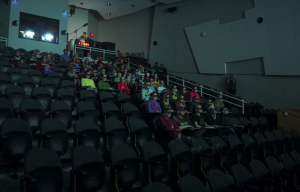
On April 12th, the ISU Magnetics Research Group (MRG) collaborated with the Virtual Reality Applications Center (VRAC) to give a series of presentations designed to inspire grade school students to follow a path into the STEM fields. The outreach program was funded by a grant from the American Physical Society (APS). The event hosted 52 students from Boone Middle School at Howe Hall Auditorium.

The presentations included 3D visualization methods using virtual reality with a virtual 3D tour of the VRAC, magnetic fields and how they are used for treating neurological diseases through Transcranial magnetic Stimulation (TMS), and a live demonstration of the Human-Human Interface that shows how electrical signals from one person’s arm can be used to trigger muscle movement in another person’s arm. The MRG plans on continuing the outreach program next year.
Joe Boldrey, a research graduate assistant, thought the presentations were not only valuable to the students, but to the field as a whole.
“The program gave me an opportunity to show that the academic rigors of engineering are not an end unto themselves,” Boldrey said. “There is a human connection between the math, physics and computers with real-world applications that help people live better, longer and happier lives. I believe it is important to show younger students that connection in the hopes that it will give purpose and motivation at difficult times during undergraduate engineering coursework.”
Overall, there was a positive response from the young students who participated in the presentations. One student said, “It was an interesting trip and I would love to learn more about virtual reality.” Another said, “I think it would be a cool job [engineer] to have, especially because I know more about it.”
PI: Dr. Ravi L. Hadimani, Adj. Asst. Prof., ECpE
Co-PI: Dr. David C. Jiles, Chair, ECpE
Co-PI: Dr. Vijay Kalivarapu, Staff Scientist, VRAC
Co-PI: Dr. Eliot H. Winer, Associate Director, VRAC








